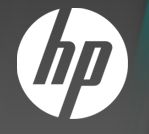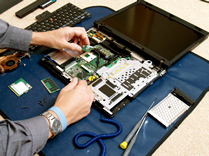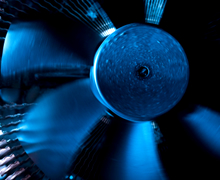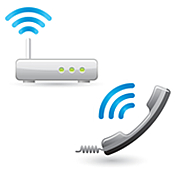Archive for the ‘Hardware Overview’ Category
Description of ‘Hardware Overview’ Category: Overview/introductory posts dealing with a particular piece of technology. May be computer parts or devices.
Friday, August 19th, 2011
Thursday August 18, 2011 Hewlett-Packard confirmed both their recent discussion with Autonomy Corporation regarding a possible offer for the company as well as the upcoming discontinuation of their webOS devices. In a press release HP expressed their plans to discontinue production for webOS devices including the recently released HP Touch Pad. HP also reported that its board of directors had approved the exploration of strategic alternatives and that they will be considering a wide range of options such as full or partial separation of the Personal Systems Group from HP through a spin-off or other transaction.

from http://www.hp.com, August 2011
This decision follows only 2 months after HP latest product launch, the HP Touch Pad. The HP Touch Pad was initially thought to be a major competitor for the iPad. However, following a rocky launch that included an announcement of a better model just days after the initial release, drastic price changes, and bad PR it was clear that HP had fumbled the release and the HP Touch Pad didn’t stand a chance against the iPad or other competitors.
Along with the dwindling release sales for their new tablet HP was also far behind their mobile competitors. Although the fastest growing consumer electronics are mobile devices according to HP’s chief financial officer Cathy Lesjak “the webOS would require significant investments over the next five years, generating a risk without clear rewards”. HP webOS users currently only account for 3% of the market while Android occupies a steady 40% and Apple controlling fewer than 30%.
HP also faced struggles obtaining developers to build applications for their devices. The more developers there are usually means more applications and more importantly more customers. However because the platform with the most developers usually attracts the most customers and the platforms with the most customers usually draw in the most developers it can be very difficult for new devices and platforms to even get off the ground.
HP now seems to be modifying their strategy and shifting from consumer electronics to developing large software for businesses. This new direction is evident with the latest $10 million acquisition for Autonomy. According to Léo Apotheker, HP president and chief executive officer
“Autonomy presents an opportunity to accelerate our strategic vision to decisively and profitably lead a large and growing space,” said. “Autonomy brings to HP higher value business solutions that will help customers manage the explosion of information. Together with Autonomy, we plan to reinvent how both unstructured and structured data is processed, analyzed, optimized, automated and protected. Autonomy has an attractive business model, including a strong cloud based solution set, which is aligned with HP’s efforts to improve our portfolio mix. We believe this bold action will squarely position HP in software and information to create the next-generation Information Platform, and thereby, create significant value for our shareholders.”
What does this mean for Apple and Google? Although this has been major news from HP their decision isn’t likely to impact their competitors because they were not a major threat to begin with.
Along with the HP Touch Pad other discontinued HP devices include HP Palm Pre 2, HP Palm Pre Plus, HP Palm Pixi, HP Veer, and the HP iPAQ Glisten.
Thanks for Reading and Have a Great Day!
Dustin
ComputerFitness.com
Providing Tech Support for Businesses in Maryland

Tags: consumer electronics, device, HP, hp touch pad, mobile device, smartphone, webOS
Posted in Electronics, Hardware Overview, SmartPhone | No Comments »
Wednesday, January 5th, 2011
 For most of us we use computers because they make mundane tasks easier and we typically don’t think twice or concerned about how they are able to accomplish all that they do. Have you ever wondered what makes your computer tick? It would be helpful to be aware of the basic components that make up your computer. Whether it is to understand a sales person, identify a problem, or for a general understanding, knowing the basics about your computer can be very useful. For most of us we use computers because they make mundane tasks easier and we typically don’t think twice or concerned about how they are able to accomplish all that they do. Have you ever wondered what makes your computer tick? It would be helpful to be aware of the basic components that make up your computer. Whether it is to understand a sales person, identify a problem, or for a general understanding, knowing the basics about your computer can be very useful.
You probably know that your computer is made up of both hardware and software. Software is the programming that tells the computer what to do, how to do it, and which devices to use. The following are hardware devices located in your computer.
#1 – CPU
A CPU or Central Processing Unit is the processor or brain of your computer. This small device is the most important component of your computer. It understands the programs, receives instructions from the user, and delivers the results.
#2 – RAM
Random Access Memory or Computer Memory enables space for the computer to read and write temporary data. The data that is stored in the RAM is only available to the CPU while the computer is running and once the computer is turned off the data being stored in RAM will be cleared.
#3 – Hard Drive
The hard drive is the storage center of your computer. It keeps the contents of your desktop and is accessed by RAM. The RAM displays the information while the hard drive stores it.
#4 – Video Card and Sound Card
These cards have their own RAM and although it is this RAM that holds the data you need to hear or see, it is the video and sound card that transfers it into actual images or sounds. A video card transfers the data to the monitor whereas the sound card transfers the data to the speakers or headphones.
#5 – Network Interface Card (NIC)
A NIC is used to pass on information from your PC to a broadband modem. It both sends and receives data over a local area network (LAN).
#6 – Mother Board
A Mother Board is the largest component of a computer is a circuit board that holds or connects to all of the other components.
#7- Computer Software
Computer Software is any program that has written instructions or machine code that is to be carried out by the computers components. Software basically tells the hardware what to do and how to do it.
Additional components include input and output devices. Input devices are used to communicate messages or instructions from the user to the computer and output devices transmit the results from the computer to the user.
| Input |
Output |
| Microphone
Keyboard
Mouse
Joystick
Scanner
Webcam
Digital Camera
Touch pad
Touch screen |
Speaker
Monitor
Printer
Headphone |
It’s clear that you don’t necessarily need to know what makes up your computer or how it gets things done. But it is still always good to have some understanding of what is going on behind the scenes.
For more information on computer components check out the following links:
Have a Great Day!
Dustin
ComputerFitness.com
Providing Tech Support to Businesses in Maryland

Tags: component, components, computer, computer devices, hard drive, Software
Posted in Hardware Overview, PC, PC Maintenance, Software | 1 Comment »
Thursday, November 4th, 2010

Hey, everyone, Josh from Computer Fitness back with another award-winning article to help you with your computer conundrums.
So you need a new computer? Well, it happens to all of us. Eventually our machines, even though they were once powerhouses, need to be replaced. Now, if you’ve been out of the game for a while, you might not know about everything you need to for today’s applications. Well, here are some things to look for when picking up or building a new computer.
Processor (CPU)
The CPU, or Processor, in a computer is what helps it perform most of its duties. The CPU allows the computer to solve equations, execute tasks, etc. The faster this is, the quicker programs will run. Now, for today’s applications, you want something in the Dual Core line with at least 2.5 GHz for each core. If you really want a screaming fast machine, go with a Quad Core at 3.0 GHz or more. The latter is good for gaming or advanced graphical work, while the former will be good for day to day processing without the need for upgrades in the near future.
Memory (RAM)
While the CPU helps to run programs, the RAM assists. RAM is temporary memory used to store the data needed to run programs. RAM holds the data and the CPU processes it. Now, you want at least 2GB of DRR2 RAM these days, though 4GB of DDR3 RAM would be better. Most operating systems will use up 1GB to start, so you’d already be 50% down with 2GB. Better to go with the 4GB, in my opinion.
Storage Space (Hard Drive)
Think of this like your brain’s long-term memory. You use the Hard Drive (HDD) to store data permanently. This is used to hold your operating system, photos, documents, etc. Bigger is better here, so go with at least 400 GB. Now, if you’ve embraced the digital age and frequently purchase games, movies, and music online, I’d recommend going with 1 TB for your HDD. You’ll avoid needing a backup soon, besides using multiple drives can get complex.
-Josh
Computer Fitness

Tags: HDD, mac, new computer, pc, RAM, Specs
Posted in Hardware Overview, Mac and PC, PC | No Comments »
Wednesday, June 30th, 2010
 Hey, everyone. It’s Josh from Computer Fitness again. We are a Tech Support Company for Small and Medium businesses located in Reisterstown, MD. Hey, everyone. It’s Josh from Computer Fitness again. We are a Tech Support Company for Small and Medium businesses located in Reisterstown, MD.
Most people today is familiar with Bluetooth technology. It’s not universal yet, but lots of devices use it. The most common use of Bluetooth is wireless headsets for cell phones. Bluetooth is designed to facilitate something that we tech nerds call the PAN, or Personal Area Network. This is just like a WAN or LAN, however the scope is incredibly limited, specifically, to your person. It has a lot of really cool applications, but there are also some drawbacks.
Benefit: Limited in Scope
This may seem like a drawback for some users, but this is actually a positive. It keeps people from having too many connections overlapping each other. Also, it prevents others from trying to join your PAN all the time.
Benefit: Many Connections Available
Bluetooth functions a lot like Wireless networks, so it supports multiple connections at once. While the bandwidth is not especially great, you can easily support several devices. Typically, in the case of computers, you will see a keyboard, mouse, and headset using Bluetooth to connect. Room still exists for other devices as well.
Drawback: Bluetooth isn’t 100% Secure
Most techs will also tell you that Bluetooth, while a great technology, is not especially secure. Most devices use very simple PINs to enable security/attach to a network. Sometimes, these devices use the standard default password of 0000. Bear this in mind when using Bluetooth.
-Josh
Computer Fitness
Onsite and Remote Tech Support

Tags: Bluetooth, LAN, PAN, Smart Phone, WAN, Wireless
Posted in Hardware Overview | 1 Comment »
Thursday, May 27th, 2010
 Hello and welcome to Computer Fitness’ Blog! My name is Josh. Computer Fitness is a tech support firm for small and medium businesses in Reisterstown, MD. Our areas of expertise run the gamut from workstation repair to server maintenance. Hello and welcome to Computer Fitness’ Blog! My name is Josh. Computer Fitness is a tech support firm for small and medium businesses in Reisterstown, MD. Our areas of expertise run the gamut from workstation repair to server maintenance.
If you’re looking to get a new hard drive or computer, one of the first things you’ll likely look at is the size of the drive. You’ll try to figure out how much space you use now and how much you think you’ll use in the future. All of that is great, but a growing option for the hard drive is now the choice of a traditional drive, which utilizes spinning plates to hold data, or a solid state drive, which is very similar to the memory cards used in cameras, iPods, etc. This may not seem important at first, aside from the price. However, take a close look at three things to consider when buying a new hard drive.
1) Solid State Drives Have No Moving Parts
This is a winner for all you laptop owners out there who keep dropping your machine. Since there are no moving parts, falling won’t damage any delicate equipment located on the inside of the drive. A traditional drive might crash if dropped. Solid State drives win here. However, if you are getting a desktop, don’t even worry about this part.
2) Traditional Hard Drives Last Longer
Not too long ago, solid-state drives were said to have a lifespan of about two years. They’ve doubled that since then, but the fact of the matter is that a traditional drive was last longer. If you’re a techie who is always upgrading, this may not be a concern for you. However, it is something to consider.
3) Solid State Drives are VERY Expensive
If it just comes down to money for you, a solid-state drive is not your choice. They are much more expensive. This is due to the newness of the technology, combined with what it takes to make them. If you are looking for crash protection for a laptop, it might be worth the money. Otherwise, go with the traditional drive.
That’s all for this week. Check back again for more computer fitness tips!
-Josh
Computer Fitness
Onsite and Remote Tech Support

Tags: hard drive, Hardware, HDD, Solid State Drive, SSD
Posted in Hardware Overview | No Comments »
Thursday, May 20th, 2010
 Hello and welcome to Computer Fitness’ Blog! My name is Josh. You may know me from the Internet Beacon. We have a pretty cool blog over there. If you’re new to our sites, do check it out; there’s plenty more awesome over there. Computer Fitness is a tech support firm in Finksburg, MD. Our areas of expertise run the gamut from workstation repair to server maintenance. Hello and welcome to Computer Fitness’ Blog! My name is Josh. You may know me from the Internet Beacon. We have a pretty cool blog over there. If you’re new to our sites, do check it out; there’s plenty more awesome over there. Computer Fitness is a tech support firm in Finksburg, MD. Our areas of expertise run the gamut from workstation repair to server maintenance.
For the most part, we all take pretty good care of our computers. We make sure the screens are free of spots, sometimes wipe down the keyboard and mouse, and generally make sure we don’t spill coffee in that cup holder thing that comes out of it. However, there may be a vital area you are missing in your attempts to keep your system clean: the inside. I know what you’re thinking, “Why would the inside of my computer be dirty? It’s not like I open it.” Well, that’s a logical assumption. However, it’s incorrect.
The best way to keep your computer cool while it’s working hard while you’re working hard…or playing games on your desk…is through fans strategically placed on the case. They are located at different places on most laptops, but desktops are our focus today. As with all fans, they exchange air at a rapid rate to keep things cool. Because of this, dust builds up. And unbeknownst to you, inside of your computer case could be the secret location of every dust bunny ever conceived by human clutter. Fear not, you can prevent this.
Opening your PC case is not something I recommend if you have an IT department or even an IT guy/gal at your work. They will not want you opening your case for a myriad of reasons. This is for your home PC. If you have permission from your IT people, then feel free to do this at work, too. However, please don’t assume you can open it up. This has caused many headaches for techs all over the world. Also, and this is important, TURN THE COMPUTER OFF BEFORE PROCEEDING. Sorry, I got carried away for a second.
Anyway, to open your case, most computers have two screws on the back side of the case. They are often big enough for your thumbs to turn, and they will let you open up your computer. Inside, you may either find a pristine Eden or a dust-covered wasteland…or somewhere in between. If it leans more towards the latter, then grab a can of compressed air and lightly spray the area inside to get the dust out. Make sure to read the back of the can to use it properly. Also, pay attention to the fans, as they may have some build-up from keeping your PC cool while you play Quake at 3 AM.
Once you’re finished, just close the case back up and turn on the machine. You shouldn’t have any problems and you may even notice the disappearance of some minor background noise from your machine, though this is not guaranteed. That’s all for now. Your PC should be as clean inside as outside, so make sure to perform this maintenance once every few months.
-Josh
Computer Fitness
Onsite and Remote Tech Support

Tags: case, computer, inside, pc, pc case
Posted in Desktop - Workstation, Hardware Overview | No Comments »
Thursday, April 29th, 2010
 Hello and welcome to Computer Fitness’ Blog! My name is Josh. You may know me from the Internet Beacon. We have a pretty cool blog over there. If you’re new to our sites, do check it out; there’s plenty more awesome over there. Computer Fitness is a tech support firm in Finksburg, MD. Our areas of expertise run the gamut from desktop repair to server maintenance. Hello and welcome to Computer Fitness’ Blog! My name is Josh. You may know me from the Internet Beacon. We have a pretty cool blog over there. If you’re new to our sites, do check it out; there’s plenty more awesome over there. Computer Fitness is a tech support firm in Finksburg, MD. Our areas of expertise run the gamut from desktop repair to server maintenance.
Certainly a wireless world makes things a lot easier. Think about all the wireless technology you own. It could be a lot or just a cordless phone for your landline. If it’s just the phone, maybe grab some new stuff. That’s just me. We tech folks tend to push for the latest and greatest. However, there are times when you need to carefully consider which technologies you employ.
In this case, wireless technologies often operates on the same frequency. That frequency is the 2.4ghz range. This frequency is the standard for wireless devices and, as such, can be a bit problematic on occasion. Think about your cordless phone, wireless router (Wireless A/B/G 802.11), wireless mouse, etc. all talking on the same line. It can be troublesome.
The best way to avoid this is to make sure there is enough space between the devices. I know this may sound like a simple solution, but it has proven to be the best one. For example, many people have their desktop computers right next to their routers. Not everyone, but a lot. If you have a wireless mouse broadcasting on the same frequency as the router, you may notice your mouse being a bit jumpy or unresponsive at random times. This is because two different data streams are broadcasting on the same frequency in close proximity. In this case, it might be best to just switch to a wired mouse. This is just one example of a potentially problematic interaction.
In the end, just make sure that you give your devices enough space to function properly. And, if it means being mildly inconvenienced to ensure they all play nice together, it’s worth it. That’s all for this week. Come back again for more Computer Fitness tips.
-Josh
Computer Fitness
Onsite and Remote Tech Support

Tags: Hardware, Peripherals, WiFi, Wireless
Posted in Hardware Overview | 3 Comments »
Thursday, April 8th, 2010
 Hello and welcome to Computer Fitness’ Blog! My name is Josh. You may know me from the Internet Beacon. We have a pretty cool blog over there. If you’re new to our sites, do check it out; there’s plenty more awesome over there. Computer Fitness is a tech support firm in Finksburg, MD. Our areas of expertise run the gamut from desktop repair to server maintenance. This week I’d like to talk about processors. Hello and welcome to Computer Fitness’ Blog! My name is Josh. You may know me from the Internet Beacon. We have a pretty cool blog over there. If you’re new to our sites, do check it out; there’s plenty more awesome over there. Computer Fitness is a tech support firm in Finksburg, MD. Our areas of expertise run the gamut from desktop repair to server maintenance. This week I’d like to talk about processors.
Sure, it sounds cool, but does it really benefit you? Companies love to tout the latest and greatest technological advances. They tell you that you need their products and that without them, your computer will be drastically slower. This is partially true. Yes, these processors can be considerably faster, but only in specific circumstances. The number of cores on a processor really reflects how much it can do and the amount of processors on the chip. For example, a quad-core processor has four processors on one chip.
This means it can do drastically more than an older, singe core processor. However, the biggest bonuses will be noticed in programs that are designed to take advantage of these processors. A great example of this is new operating systems for Apple and Microsoft. Windows 7 and Mac OS 10.6 (Snow Leopard) operate in what is called “64-bit” mode. This means that the amount of memory they use is greater, but it affords faster processing.
At the end of the day, you need to determine if you really need the processing power these chips offer. In my off time, I play games on my PC, so getting a faster processor for the latest games makes sense to me. However, if you are simply doing word processing and basic Internet use, then paying for this extra perk is not worth it.
Well, that’s all I have for you this week. Thanks for stopping by.
-Josh
Computer Fitness
Onsite and Remote Tech Support

Tags: computer, faster, processing, processor, Processors
Posted in Desktop - Workstation, Hardware Overview | No Comments »
Saturday, March 27th, 2010
 Hello and welcome to Computer Fitness’ Blog! My name is Josh. You may know me from the Internet Beacon. We have a pretty cool blog over there. If you’re new to our sites, do check it out; there’s plenty more awesome over there. Computer Fitness is a tech support firm in Finksburg, MD. Our areas of expertise run the gamut from desktop repair to server maintenance. This week I’d like to talk about RAM. Hello and welcome to Computer Fitness’ Blog! My name is Josh. You may know me from the Internet Beacon. We have a pretty cool blog over there. If you’re new to our sites, do check it out; there’s plenty more awesome over there. Computer Fitness is a tech support firm in Finksburg, MD. Our areas of expertise run the gamut from desktop repair to server maintenance. This week I’d like to talk about RAM.
Now, most people know what RAM does. If you don’t, here’s a quick rundown. RAM stands for Random Access Memory. Computer programs will take a chunk of it to run a program and then return it when they are finished. This is different from your Hard Drive, which stores data more or less permanently until you say otherwise.
Getting back to RAM, the more the better is generally true. However, there are cases when this may not be exactly true. While increasing the amount of RAM in your computer is almost always good, there are rules. There are two things I would like to caution users to take into account when purchasing RAM.
Teamwork is Key
RAM works best in pairs. When your PC/MAC uses RAM, it runs quicker and smoother when the amount of RAM you have is based on two similar chips. In essence, if you have 1 GB of RAM, you’re best speeds will come out of a pairing of two 512 MB chips. This rule applies as you increase the memory.
Ask Your Mother
Your motherboard, or Mainboard, is like the nervous system/brain of your computer, in that it deals with everything attached to the computer. What you want to take into account here is the maximum possible RAM that it can support. No technology is without limitations, and planning for the future is important. When ordering/building a new PC, check the maximum amount of RAM supported by the Motherboard.
If it is only twice what is currently in the PC, you may find yourself buying a new computer in 2-3 years rather than 5-6. The best part of desktop computers is the ease of upgrading. By not checking the computer’s limitations, you could end up spending a great deal more money than necessary.
Well, that’s all for this week. Come back next week for more tech tips!
-Josh
ComputerFitness.com
Baltimore Tech Support

Tags: computer, pc, RAM, support, tech support
Posted in Hardware Overview | 1 Comment »
|












 Hello and welcome to
Hello and welcome to 

